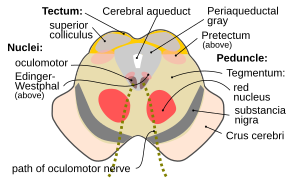Location and Structure of the Oculomotor Nucleus
- The oculomotor nucleus is located in the midbrain.
- It lies in the gray substance of the floor of the cerebral aqueduct.
- The nucleus extends in front of the aqueduct for a short distance into the floor of the third ventricle.
- Fibers of the oculomotor nerve arise from this nucleus.
- The nucleus is divided into anterior and posterior groups.
Pathway of the Oculomotor Nerve
- The fibers of the oculomotor nerve pass forward through the tegmentum, the red nucleus, and the medial part of the substantia nigra.
- They form a series of curves with a lateral convexity.
- The fibers emerge from the oculomotor sulcus on the medial side of the cerebral peduncle.
- The oculomotor nerve does not consist of a continuous column of cells but is broken up into smaller nuclei.
- The posterior group of nuclei is symmetrical on both sides, while the anterior group consists of two nuclei.
Physiological Subdivisions of the Oculomotor Nucleus
- The oculomotor nucleus can be subdivided into smaller groups of cells.
- Each group controls a particular muscle.
- This subdivision allows for precise control of eye movements.
- The oculomotor nucleus is responsible for coordinating the movements of multiple eye muscles.
- Dysfunction of the oculomotor nucleus can result in various eye movement disorders.
Role of the Edinger-Westphal Nucleus
- The Edinger-Westphal nucleus is located dorsal to the main oculomotor nucleus.
- It is responsible for the autonomic functions of the oculomotor nerve.
- The Edinger-Westphal nucleus controls pupillary constriction.
- It also regulates lens accommodation, allowing the eye to focus on near objects.
- Dysfunction of the Edinger-Westphal nucleus can lead to pupillary abnormalities and impaired lens accommodation.
Additional Images and External Links
- The article includes additional images related to the oculomotor nucleus.
- These images illustrate the anatomical features and central connections of the oculomotor nerve.
- External links provide further resources for studying the oculomotor nucleus.
- The University of Michigan Health System offers an atlas image of the brainstem and cranial nerve nuclei.
- The BrainMaps project provides stained brain slice images that include the oculomotor nucleus.
This article includes a list of references, related reading, or external links, but its sources remain unclear because it lacks inline citations. (May 2015) |
The fibers of the oculomotor nerve arise from a nucleus in the midbrain, which lies in the gray substance of the floor of the cerebral aqueduct and extends in front of the aqueduct for a short distance into the floor of the third ventricle. From this nucleus the fibers pass forward through the tegmentum, the red nucleus, and the medial part of the substantia nigra, forming a series of curves with a lateral convexity, and emerge from the oculomotor sulcus on the medial side of the cerebral peduncle.
| Oculomotor nucleus | |
|---|---|
 Section through superior colliculus showing path of oculomotor nerve. | |
 The cranial nerve nuclei schematically represented; dorsal view. Motor nuclei in red; sensory in blue. (Oculomotor is "III") | |
| Details | |
| Identifiers | |
| Latin | nucleus nervi oculomotorii |
| MeSH | D065838 |
| NeuroNames | 492 |
| NeuroLex ID | birnlex_1240 |
| TA98 | A14.1.06.302 |
| TA2 | 5892 |
| FMA | 54510 |
| Anatomical terms of neuroanatomy | |
The nucleus of the oculomotor nerve does not consist of a continuous column of cells, but is broken up into a number of smaller nuclei, which are arranged in two groups, anterior and posterior. Those of the posterior group are six in number, five of which are symmetrical on the two sides of the middle line, while the sixth is centrally placed and is common to the nerves of both sides. The anterior group consists of two nuclei, an antero-medial and an antero-lateral.
The nucleus of the oculomotor nerve, considered from a physiological standpoint, can be subdivided into several smaller groups of cells, each group controlling a particular muscle.
A nearby nucleus, the Edinger-Westphal nucleus lies dorsal to the main oculomotor nucleus. It is responsible for the autonomic functions of the oculomotor nerve, including pupillary constriction and lens accommodation.